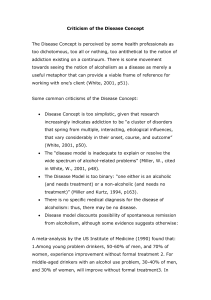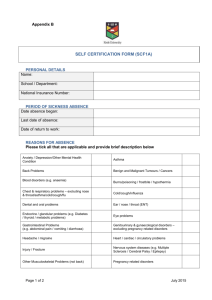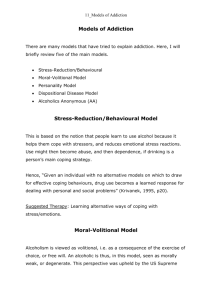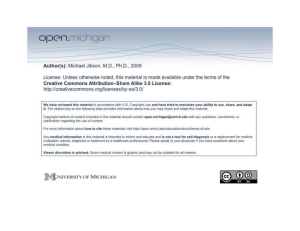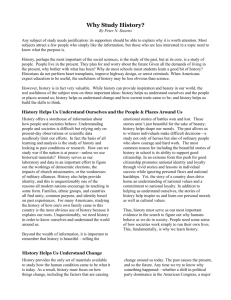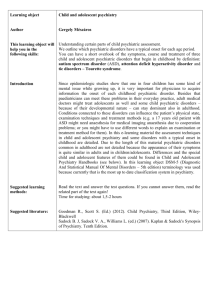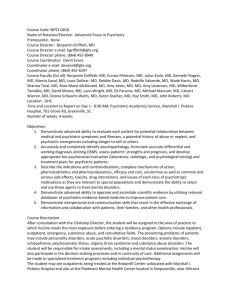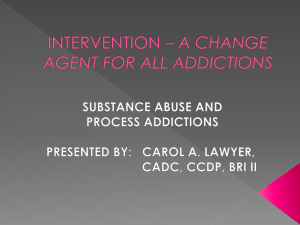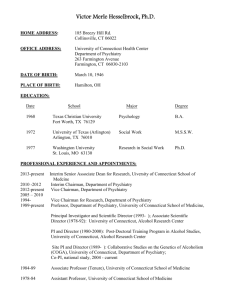this Outline
advertisement
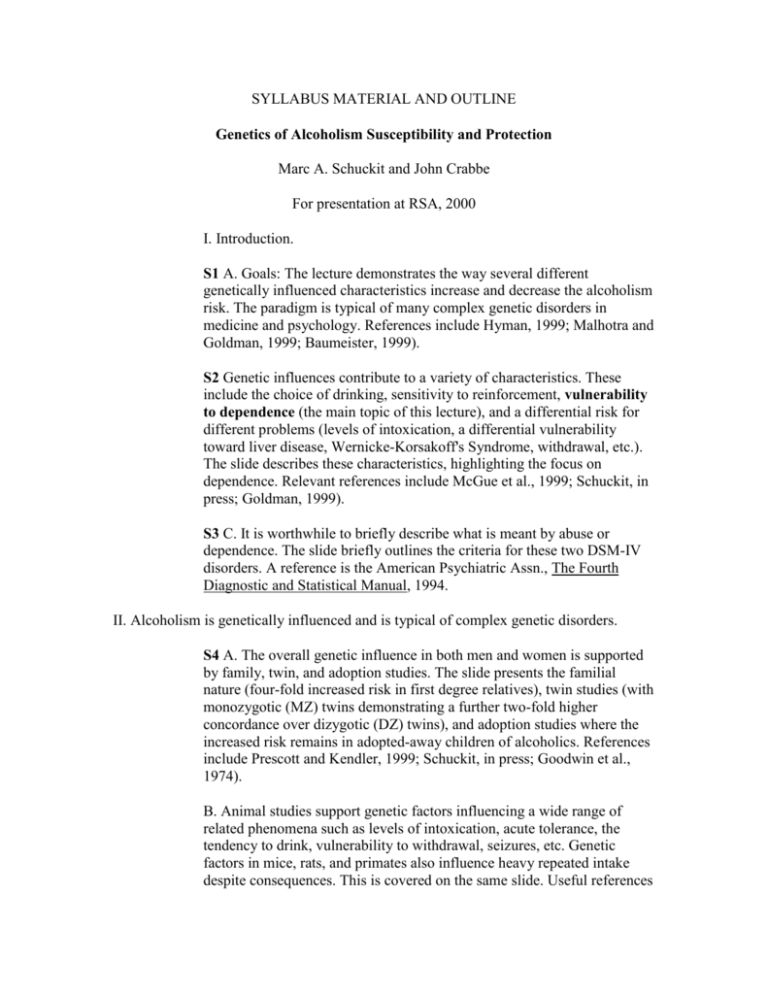
SYLLABUS MATERIAL AND OUTLINE Genetics of Alcoholism Susceptibility and Protection Marc A. Schuckit and John Crabbe For presentation at RSA, 2000 I. Introduction. S1 A. Goals: The lecture demonstrates the way several different genetically influenced characteristics increase and decrease the alcoholism risk. The paradigm is typical of many complex genetic disorders in medicine and psychology. References include Hyman, 1999; Malhotra and Goldman, 1999; Baumeister, 1999). S2 Genetic influences contribute to a variety of characteristics. These include the choice of drinking, sensitivity to reinforcement, vulnerability to dependence (the main topic of this lecture), and a differential risk for different problems (levels of intoxication, a differential vulnerability toward liver disease, Wernicke-Korsakoff's Syndrome, withdrawal, etc.). The slide describes these characteristics, highlighting the focus on dependence. Relevant references include McGue et al., 1999; Schuckit, in press; Goldman, 1999). S3 C. It is worthwhile to briefly describe what is meant by abuse or dependence. The slide briefly outlines the criteria for these two DSM-IV disorders. A reference is the American Psychiatric Assn., The Fourth Diagnostic and Statistical Manual, 1994. II. Alcoholism is genetically influenced and is typical of complex genetic disorders. S4 A. The overall genetic influence in both men and women is supported by family, twin, and adoption studies. The slide presents the familial nature (four-fold increased risk in first degree relatives), twin studies (with monozygotic (MZ) twins demonstrating a further two-fold higher concordance over dizygotic (DZ) twins), and adoption studies where the increased risk remains in adopted-away children of alcoholics. References include Prescott and Kendler, 1999; Schuckit, in press; Goodwin et al., 1974). B. Animal studies support genetic factors influencing a wide range of related phenomena such as levels of intoxication, acute tolerance, the tendency to drink, vulnerability to withdrawal, seizures, etc. Genetic factors in mice, rats, and primates also influence heavy repeated intake despite consequences. This is covered on the same slide. Useful references include Li, 2000; Crabbe, 1999; Schuckit, in press, Prescott and Kendler, 1999). S5 C. The complex nature of genetic influences in alcoholism reflects the fact that at least 40% of the risk is explained by environment; many of the genetically influenced characteristics are controlled by multiple genes; and there are multiple avenues of increased and decreased risk. The remainder of the lecture discusses many of these potential avenues that impact on the risk. The slide describes the importance of environment, the polygenic nature of the disorder, and the fact there are multiple avenues in or away from alcohol problems. S6 D. Among the characteristics that impact on the alcoholism risk and which will be discussed in this lecture are some risk-related genes (e.g., ALDH2-2) and broader phenotypes which reflect, at least in part, other risk-related genes. Examples include alcohol metabolizing enzymes; disinhibition (or impulsiveness/ASPD/low P3 amplitude/etc.); a low level of intensity of response to alcohol; independent psychiatric disorders such as manic depressive disease and schizophrenia; the opioid system; functioning of many different neurotransmitter systems, etc. The slide introduces these topics which will then become the focus of a discussion in themselves in the following sections. Useful references include Schuckit, in press; Goldman, 1999; Hyman, 1999. III. The best documented set of genetic influences in alcoholism relates to alcohol metabolizing enzymes. These are generally protective of the alcoholism risk. References for the following data include Li, 2000; Wall et al., 1999; Higuchi et al., 1995; Neumark et al., 1998; Whitfield et al., 1998). S7 A. There are multiple pathways for metabolizing alcohol (e.g., nonenzymatic avenues, the microsomal ethanol oxidizing system or MEOS, and catalase), but most of the data relate to alcohol and aldehyde dehydrogenases (ADH and ALDH). The slide shows the metabolism of alcohol by enzymes controlled by alleles of ADH and ALDH, emphasizing the importance of the production of acetaldehyde. The same slide highlights the relevant alleles associated with high acetaldehyde levels. B. If alcohol is metabolized more rapidly, or (probably even more importantly) if the first breakdown product (acetaldehyde) is broken down more slowly, there is both an increased intensification of response to alcohol (as described by Wall et al., 1999) and a potentially adverse reaction to alcohol. This doesn't require a slide by itself, and the prior slide should remain on. C. There are a number of important alleles that produce different forms of ALDH, with ALDH2-2 having a major impact on the alcoholism risk. The importance of homozygotes versus heterozygotes should be presented; the associated risks for alcoholism discussed; along with the increased risk for potential organ damage in heterozygotes who choose to drink heavily. The impact of environment in moderating the consequences of the ALDHrelated alleles should also be discussed. The same slide demonstrates the different alleles and the different forms of ALDH. D. A similar case can be made regarding alcohol dehydrogenase isoenzyme forms, especially those that relate to ADH2-2, 2-3, and 3-1. The impact that these relevant alleles might have on Caucasians as well should be mentioned. E. A summary of the importance of alcohol-metabolizing enzymes should be presented. Emphasis can be placed on the fact that this is one genetic road of influence relating to alcoholism, and that this appears to be relatively independent of the other roads discussed in other sections of this lecture. This is a good example of how genes and environment and interact (e.g., with heterozygotes for ALDH). IV. An increased genetic risk for alcoholism through disinhibition and/or impulsivity. S8 A. Neuronal disinhibition and/or high levels of impulsivity form the core of this possible domain and might relate to a number of additional overlapping phenomena. These include the low amplitude of the P3 wave of the event related potential (ERP), the antisocial personality disorder (ASPD)/conduct disorder (CD), as well as Type II and Type B alcoholism. A slide presents this group of characteristics. These phenotypes might relate to several physiological phenomena. Useful references for this section include Begleiter and Porjesz, 1999; Bauer and Hesselbrock, 1999; Hill et al., 1999; Ehlers et al., 1998; Cloninger et al., 1999; Disney et al., 1999. S9 B. There are a number of potentially important additional characteristics that might relate to the disinhibition domain. These might include genetic material that impacts on low levels of serotonin (5-HT) functioning, and, perhaps, the D2 dopamine receptor (DRD2) gene (although the latter is more controversial. The student should be reminded that these additional characteristics might operate independently of disinhibition, but for heuristic purposes they are being discussed together. Markers related to the disinhibition domain, however, appears to be independent of alcohol-metabolizing enzymes and the intensity of response to alcohol (the next topic). Useful references include Hill, 2000; Lappalainen et al., 1998; Edenberg et al., 1999. C. The potential mechanisms of the increase in risk might occur via impulsivity and problems learning from mistakes, as well as difficulty in modifying behavior when living in a heavy drinking environment. It is also possible these people use alcohol to decrease symptoms related to neuronal disinhibition. D. Data support the importance of genetic influences in these characteristics. A brief description of genetic influences in ASPD and the P3 amplitude should be reviewed. A slide outlines these basic findings. E. There are data that these characteristics are involved with an increased alcoholism risk. There are also data that children of alcoholics are more likely than controls to have some of these characteristics. No specific slide is needed for this point as the prior slide can remain on the screen. V. A low level of response to alcohol as it relates to the alcoholism risk. S10 A. A low response to alcohol can be documented as less change in body functioning at a given blood alcohol level, or a report of the need for a greater number of drinks to have a particular effect early in the drinking career. A low response can also be bred into animals. Useful references for this section include Schuckit and Smith, submitted; Volavka et al., 1996; Health et al., 1999; Wall et al., 1999; Tecott and Heberlein, 1998; Erblich and Earleywine, 1999; Thiele et al., 1998; Hodge et al., 1999; Schuckit et al., 1999. B. The low response to alcohol might increase the risk for heavier drinking per occasion as people have less feedback that they are becoming intoxicated. It is also possible that they require more alcohol to get the level of intoxication others experience, so they drink more to gain that experience. The prior slide should remain on. S11 C. The intensity of response to most substances, including alcohol, is likely to be genetically influenced with heritabilities of between 0.4 and 0.6. Useful references include Martin, 1988; Heath et al., 1999; Schuckit et al., submitted. The slide highlights the material in C and D. D. The low response to alcohol correlates with the family history of alcoholism and predicts alcoholism in 4- to 20-year prospective studies in the U.S., Denmark, and Australia. S12 E. The low response to alcohol might also relate to several independent characteristics or markers. These include background cortical EEG findings (low voltage and a relative deficiency of alpha); neuropeptide Y; corticotropin releasing (CRF) and the hypothalamicpituitary adrenal axis (HPA); adenylyl cyclase (AC); protein kinase C (PKC); aspects of gamma amino butyric acid (GABA) functioning; and the serotonin transporter (SERT). The slide presents this information and the student will be reminded that any or all of these associated findings might also impact the risk for alcoholism through alternative mechanisms, but that presenting them as a "package" makes many of these characteristics easier to remember, and presents a potentially valid model. A slide presents these data. VI. A predisposition through genetically-influenced independent psychiatric disorders. S13 A. Forty percent or more of alcohol-dependent individuals meet criteria for another major psychiatric disorder. Especially relevant are bipolar manic depressive disease, schizophrenia, panic disorder, and social phobia. Each of these conditions is genetically influenced, and the disorders might themselves increase the risk for persistent alcohol problems. The slide demonstrates the level of crossover between alcoholism and other psychiatric disorders as discussed in A and B. Useful references include Kessler et al, 1997; Schuckit et al, 1997; Winokur et al., 1996. B. The student should be reminded that this is a complex topic because psychiatric symptoms (e.g., sadness) must be distinguished from full blown disorders (depressive episodes), and temporary symptoms seen in the context of heavy drinking (i.e., alcohol induced disorders) might not represent independent psychiatric disorders. S14 C. The crossover between alcoholism and other psychiatric disorders is likely to be the result of a variety of factors. These include temporary substance-induced disorders, escalating alcohol use in the context of poor judgement as a result of schizophrenia or bipolar manic episodes, selfmedication of psychiatric symptoms with alcohol, poverty with an associated heavy drinking environment, alterations in neurotransmitters such as dopamine, and possible linkage between genes that impact the psychiatric disorders and those that increase the risk for alcoholism. A slide presents these possibilities. D. The student should be reminded that this potential heterogeneous domain of increased genetic influence appears to be independent of alcohol-metabolizing enzymes, a low level of response to alcohol, and, probably, disinhibition. However, the potential role of additional genetically-influenced characteristics should be noted. Thus, while some dopamine-related genetic markers might influence disinhibition, others might impact on schizophrenia and, thus, indirectly increase the alcoholism risk. Similarly, some neuropeptide Y receptors might have an impact on level of response to alcohol or appetitive behaviors, while others might relate to the predisposition toward anxiety disorders. Either could enhance the alcoholism risk. A similar argument can be made regarding different aspects of the GABA system. The slide demonstrates these ideas. VII. A brief overview of some other genetically-influenced characteristics that impact on the alcoholism risk. Data from both human and animal studies relate to most of these items. Useful references for this include Menninger and Tabakoff, 1998; Wand et al, 1994; Hodge et al., 1999: Thiele et al., 1998; Ehlers et al., 1998; Gianoulakis et al., 1996. S15 A. Second messenger systems, including adenylyl cyclase, G proteins, and protein kinase (PKC) can be reviewed. The brief discussion will present the acute effects of alcohol on the system, the importance of genes, and the possible relationship to the alcoholism risk. Useful information on AC and G proteins is presented as Background for Slide 12. Slide 15 highlights this system. B. Protein kinase C might also be discussed with an emphasis on PKCε. This is also referred to in Slide 12. S16 C. The slide notes the relationship between opioid receptor activity, dopamine activity, and the effects of alcohol, and discusses the importance of genes in opioid receptor functioning and number. D. Neuropeptide Y is also interesting in this light. This is explained in the Background of the slide copy and regarding Slide 12. S17 E. Other possible markers can be mentioned, depending on the time available. These include CRF, the HPA axis, and background cortical EEG results. S18 VIII. It is important to remember that the emphasis of this lecture has been on genetic material related to the predisposition toward alcohol abuse or dependence. At the same time, important genetic influences operate regarding the vulnerability toward or away from specific sequelae of alcohol dependence among alcoholics. This slide lists the following which can then briefly be discussed. A. Wernicke-Korsakoff's syndrome. B. Cirrhosis of the liver. C. Intensity of withdrawal including convulsions. D. Psychotic symptoms. IX. The genetic factors have a potential impact on prevention and treatment. S19 This slide briefly outlines how understanding more about the mechanism of risk can help people develop prevention strategies aimed specifically at an individual's vulnerability. Thus, the impact of specific environmental events on the alcoholism risk is best understood when they are observed in the context of the specific vulnerabilities. S20 Regarding treatment, it might be more efficient to be able to test specific therapies if one can recognize potential subgroups of patients based on their initial vulnerability toward alcoholism. These issues may help explain why some treatment approaches appear promising (naltrexone is an example), but the "signal" appears to be relatively weak, perhaps because the groups being evaluated are heterogeneous with only a small subsample responding relatively intensely to the intervention. Thus, identifying subgroups of subjects carrying different risk factors could facilitate interpretation of studies like Project Match. S21 X. A brief summary of the major points made in the lecture will be presented in a single summary slide. References American Psychiatric Association: (1994) Diagnostic Criteria from DSM-IV, Washington, DC, American Psychiatric Association Press Bauer LO, Hesselbrock VM: (1999) P300 decrements in teenagers with conduct problems: implications for substance abuse risk and brain development. Biol Psychiatry 46:263-272 Baumeister M: (1999) Complex genetics and implications for psychiatry: Basic concepts in the study of diseases with complex genetics. Biol Psychiatry 45:522-532 Begleiter H, Porjesz B: (1999) What is inherited in the predisposition toward alcoholism? A proposed model. Alcohol Clin Exp Res 23:1125-1135 Cloninger CR, Adolfsson R, Svrakic NM: (1996) Mapping genes for human personality. Nature Genetics 12:3-4 Crabbe JC, Phillips TJ, Buck KJ, Cunningham CL, Belknap JK: (1999) Identifying genes for alcohol and drug sensitivity: recent progress and future directions. Trends Neurosci 22:173-179 Disney ER, Elkins IJ, McGue M, Iacono WG: (1999): Effects of ADHD, conduct disorder, and gender on substance use and abuse in adolescence. Am J Psychiatry 156:1515-1521 Edenberg HJ, Foroud T, Koller DL, Goate A, Rice J, Van Eerdewegh P, Reich T, Cloninger CR, Nurnberger JI, Jr, Kowalczuk M, Wu B, Li TK, Conneally PM, Tischfield JA, Wu W, Shears S, Crowe R, Hesselbrock V, Schuckit M, Porjesz B, Begleiter H: (1998) A family-based analysis of the association of the dopamine D2 receptor (DRD2) with alcoholism. Alcohol Clin Exp Res 22:505-512 Ehlers CL, Garcia-Andrade C, Wall TL, Sobel DF, Phillips E: (1998) Determinants of P3 amplitude and response to alcohol in Native American Mission Indians. Neuropsychopharmacology 18:282-292 Erblich J, Earleywine M: (1999) Children of alcoholics exhibit attenuated cognitive impairment during an ethanol challenge. Alcohol Clin Exp Res 23:476-482 Gianoulakis C, De Waele JP, Thavundayil J: (1996) Implication of the endogenous opioid system in excessive ethanol consumption. Alcohol 13:19-23 Goldman D: (1999) Big Mountain (Commentary). Arch Gen Psychiatry 56:553 Goodwin DW, Schulsinger F, Moller N, Hermansen L, Winokur G, Guze SB: (1974) Drinking problems in adopted and nonadopted sons of alcoholics. Arch Gen Psychiatry 31:164-169 Heath AC, Madden PAF, Bucholz KK, Dinwiddie SH, Slutske WS, Bierut LJ, Rohrbaugh JW, Statham DJ, Dunne MP, Whitfield JB, Martin, NG: (1999) Genetic differences in alcohol sensitivity and the inheritance of alcoholism risk. Psychol Med 29:1069-1081 Higuchi S, Parrish KM, Dufour MC, Towle LH, Harford TC: (1994) Relationship between age and drinking patterns and drinking problems among Japanese, JapaneseAmericans, and Caucasians. Alcohol Clin Exp Res 18:305-310 Hill SY: (2000): Biologic phenotypes associated with individuals at high risk for developing alcohol-related disorders, Part 1. Addiction Biology 5:5-22 Hill SY, Locke J, Steinhauer SR: (1999) Absence of visual and auditory P300 reduction in nondepressed male and female alcoholics. Biol Psychiatry 46:982-989 Hodge C W, Mehmert KK, Kelley SP, McMahon T, Haywood A, Foster Olive M, Wang D, Sanchez-Perez, AM, Messing RO: (1999) Supersensitivity to allosteric GABAA receptor modulators and alcohol in mice lacking PKC. Nature Neuroscience 2:997-1002 Hyman SE: (1999) Introduction to the complex genetics of mental disorders. Biol Psychiatry 45:518-521 Kessler RC, Crum RM, Warner LA, Nelson CB, Schulenberg J, Anthony JC: (1997) Lifetime co-occurrence of DSM-III-R alcohol abuse and dependence with other psychiatric disorders in the National Comorbidity Survey. Arch Gen Psychiatry 54:313321 Lappalainen J, Long JC, Eggert M, Ozaki N, Robin RW, Brown GL, Naukkarinen H, Virkkunen M, Linnoila M, Goldman D: (1998) Linkage of antisocial alcoholism to the serotonin 5-HT1B receptor gene in 2 populations. Arch Gen Psychiatry 55:989-994 Li TK: (2000) Pharmacogenetics of responses to alcohol and genes that influence alcohol drinking. J Stud Alcohol 61:5-12 Malhotra AK, Goldman D: (1999) Benefits and pitfalls encountered in psychiatric genetic association studies. Biol Psychiatry 45:544-550. Martin NG: (1988) Twin Studies of alcohol consumption, metabolism and sensitivity: Australian Drug and Alcohol Review 7:9-12 McGue M: (1999) Phenotyping alcoholism. Alcohol Clin Exp Res 23:757-758 Menninger JA, Tabakoff B: (1997) Forskolin-stimulated platelet adenylyl cyclase activity is lower in persons with major depression. Biol Psychiatry 42:30-38 Neumark YD, FriedlanderY, Thomasson HR, Li TK: (1998) Association of the ADH2*2 allele with reduced ethanol consumption in Jewish men in Israel: a pilot study. J Stud Alcohol 59:133-139 Prescott CA, Kendler KS: (1999) Genetic and environmental contributions to alcohol abuse and dependence in a population-based sample of male twins. Am J Psychiatry 156:34-40 Schuckit MA: Vulnerability factors for alcoholism. In Neuropsychopharmacology: The Fifth Generation of Progress. Davis K (ed). The American College of Neuropsychopharmacology and Lippincott Williams & Wilkins, Baltimore, MD in press Schuckit MA, Edenberg HJ, Kalmijn J, Flury L, Smith TL, Reich T, Bierut L, Goate A, Foroud T: A genome-wide search for genes relating to a low level of response to alcohol. Alcohol Clin Exp Res, submitted Schuckit MA, Mazzanti C, Smith TL, Umbereen A, Radel M, Iwata N, Goldman D: (1999) Selective genotyping for the role of 5-HT2A, 5-HT2C, and GABAα6 receptors and the serotonin transporter in the level of response to alcohol: A pilot study. Biol Psychiatry 45:647-651 Schuckit MA, Smith TL: The relationships of family history of alcoholism, a low level of response to alcohol and six domains of life functioning to alcohol abuse or dependence. J Stud Alcohol, submitted Schuckit MA, Tipp JE, Bergman M, Reich W, Hesselbrock VM, Smith TL: (1997) Comparison of induced and independent major depressive disorders in 2,945 alcoholics. Am J Psychiatry 154:948-957 Tecott LH, Heberlein U: (1998) Y do we drink? Cell 95:733-735 Thiele TE, Marsh DJ, Ste Marie L, Bernstein IL, Palmiter RD: (1998) Ethanol consumption and resistance are inversely related to neuropeptide Y levels. Nature 396:366-369 Volavka J, Czobor P, Goodwin D, Gabrielli W, Penick E, Mednick S, Jensen P, Knop J, Schulsinger F: (1996) The electroencephalogram after alcohol administration in high-risk men and the development of alcohol use disorders 10 years later. Arch Gen Psychiatry 53:258-263 Wall TL, Johnson ML, Horn SM, Carr LG, Smith TL, Schuckit MA: (1999) Evaluation of the self-rating of the effects of alcohol form in Asian Americans with aldehyde dehydrogenase polymorphisms. J Stud Alcohol 60:784-789 Whitfield JB, Nightingale BN, Bucholz KK, Madden PAF, Heath AC, Martin NG: (1998) ADH genotypes and alcohol use and dependence in Europeans. Alcohol Clin Exp Res 22:1463-1469 Winokur G, Coryell W, Endicott J, Keller M, Akiskal H, Solomon D: (1996) Familial alcoholism in manic-depressive (bipolar) disease. Am J Med Genet 67:197-201 2/c:/wp60/letters/crabbe4.wpd(3/23/00)
